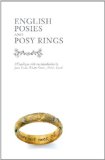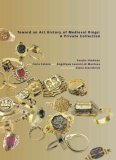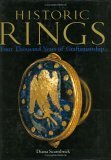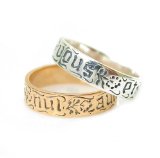






The links on this page provide examples of various styles of inscribed rings. Many of the later medieval examples are generally known as “poesy rings” (or posy rings, posie rings, posey rings, etc.), which were given as tokens of affection or as wedding rings.
These links also include memento mori rings and mourning jewelry as the list progresses into the 16th and 17th centuries.
I've set boxes around groups of rings that I think are indicative of a style or just an interesting trend.
See also Metal detecting holidays in England.
- Christie's Sale 8724, Lot 102, a Roman gold ring inscribed OMONOIA (concord/harmony), 2nd century
- Christie's Sale 9172, Lot 119, a Byzantine gold ring inscribed + A IACK IPDO ROR, c. 6th-7th century
- V&A M.173-1937, with an inscription that reads Lord, help Thy servant Nicetas captain of the imperial guard, 11th century
- Met 18.145.42, the seal of Michael Zorianos, c. 1300
- UKDFD 5088, a medieval gold ring inscribed + AVE MARIA GRACIA PLENA, 12th-13th century
- V&A M.181-1975, gold ring with a cabochon sapphire, the hoop engraved in Lombardic lettering AVE MARIA GRA[CIA] and AMOR VINCI[T] O[M]NIA, 13th century
- V&A 816-1902, gold ring with a heart-shaped bezel set with a wolf's tooth; the interior is engraved in blackletter + Buro + Berto + Berneto + Consum[m]atum e[st], 13th century (the first part of the inscription is a magical charm to protect against toothache; the second part is the last words Christ spoke on the Cross, also used as a charm to calm storms)
- Ring with interior inscribed in Lombardic lettering Ceit Mon Vie, 13th-14th century
- V&A M.184-1975, bifaceted circular hoop with Lombardic capital inscription + WEL: WERE: HIM: YAT: WISTE: * TO: WHOM: HE: MIGTE: TRISTE (Well for him who knows whom he can trust) in Lombardic capitals, c. 1300
- UKDFD 3958, a medieval copper-alloy ring with the inscription IHESVS and R repeated three times, 14th century
- Met 1994.40, sapphire ring inscribed RUTILANS EBORACI CIVITA[ti]S CANTOR (Rufus of York, Musician of the Episcopal City) on the hoop, 14th century
- V&A M.60-1960, gold posy ring inscribed + IOSVI: DE: DRVERIE: NE: ME: DVNE: MIE in Lombardic lettering, c. 1300-1350
- V&A M.275-1962, gold ring with Roman jasper intaglio surrounded by an inscription in Lombardic capitals SIGILLU. THOMASII.DE. ROGERII S.DESUESSA (referring to the owner, Thomas Roggerri of Suessa) and the hoop inscribed + ET VERBU: CARO. FACTU: E:ET ABITANT:/ NOB/ and + XPS VINCIT X XPS X REGNAT X XPS: IMPERA (And the Word was made flesh and dwelt amongst us, John, i, 14), 14th century
- V&A M.190-1975, gold ring with Roman onyx intaglio, the hoop inscribed in Lombardic lettering +IN MANUS: TUAS: DOMINE: COMENDO: SPIRITUM: MEUM. (Into your hands, O Lord, I commend my spirit, Luke 23:46), 14th century
- Lüneburg, copper ring with the inscription IASPAR : MELCHIOR : BAL, last quarter of the 14th century
- The Middleham ring, gold with an inscription of twelve letters S on the exterior and the word Sovereynly on the interior, c. 1380-1420; see also the collars of esses
- Medieval gold ring inscribed + TANT QUE MURAI +VOUZ CEROIRE (Until I die I will be yours), late 14th-15th century
- UKDFD 5100, gold ring inscribed + GOD HELP AMEN repeated on each side, late 14th-15th century
- V&A M.10-1929, copper alloy ring with an amethyst, the hoop inscribed in blackletter par / grant / amour (With great love), c. 1400
- V&A M.189-1962, gold ring with a sapphire and a garnet, inscribed oue tout mon coer (With all my heart) on the interior, c. 1400
- Gold ring with the Annunciation and inscribed A VOUS MA GRE, 1400
- Wales 2002.42H, a gold ring with images of St. Barbara and John the Baptist and inscribed Nul awt (None other), 15th century
- MoL 80.229, gold ring with ridged bezel with figures of John the Baptist, the Virgin and Child, and St. Catherine; hoop features internal inscription, mon cor avez (Have my heart), mid-late 15th century
- Wales 2001.2H, a gold ring with Mary holding the infant Jesus on the bezel and inscribed en boen an (A good year) along the hoop, 15th century
- SHM 3121, late medieval Sweden
- Musée Curtius, ring with figures of St. Anne, the Virgin and Child and inscribed L.G.F. MOM or L.G.A MOS, 15th-16th century
- Louvre OA 9524, a ring with a portrait of John the Fearless, Duke of Burgundy, and inscribed Vere iste, c. 1410-1419
- MoL 81.155, a gold ring with an exterior decorated with leaves and the interior inscribed nul autre (None other), early-mid 15th century
- 15th century gold rings found in England, including two pairs of rings; inscriptions include mon cuer entier (My whole heart), mon est desr (He is my desire), nul IB bien (None so good), and amer et sevir (Love and serve).
- GNM T 3981, 15th century (?)
- Portable Antiquities Scheme LIN-026715,/a>, late medieval gold posy ring with a blackletter inscription (possibly en or de and bon)
- MoL 80.33, gold posy ring set with a spinel and inscribed pour amor, say douc (For love, so sweet) on the exterior, mid-15th century
- Portable Antiquities Scheme BM-14CF37, gold ring with a four-petaled flower, foliage, and a blackletter inscription that seems to read + I e - l a - veil
- V&A M.222-1962, gold posy ring with sprigs and a heart and blackletter inscription + pense de moy, first half of the 15th century
- V&A M.57-1946, gold ring engraved with sprigs and Vous et nul autre (You and no other) in blackletter, first half of the 15th century
- V&A 892-1871, gold ring engraved with sprigs and the words Pors tous jours (For all days), 15th century
- UKDFD 10168, gold posy ring engraved + Mon Cuer Avez on the exterior, 15th century
- MoL A22158, gold ring with external inscription Je me tien (I am constant), 15th century
- British Museum 1960,1103.1, gold posy ring with exterior incised with flowers and leaves and the inscription en bon an in blackletter, 15th century
- Winchester WINCM:AY 204, silver ring that was once gilded, inscribed en bon an (A good year), 15th century
- MoL A24240, gold posy ring engraved with flowers and leaves and the words en bon an (A good year), 15th century
- Berganza 18034, inscribed en bon an, 15th century
- V&A 7125-1860, gold posy ring inscribed Autre ne vueil (Desire no other), 15th century
- V&A M.182-1937, gold ring chased with foliage, birds and a scroll inscribed Myn. Genyst. (My heart), c. 1500
- British Museum 1856,0627.152, inscribed vivat rex et lex (Long live the crown and the law) in blackletter, 15th century
- British Museum 1879,0820.1, inscribed LEGIS + EXECVO * REGIG + PSERVA * (The execution of the law and the preservation of the crown), 1521
- British Museum AF.1746, inscribed + EXECVCO REGIS PSERVACIO LEGIS (The execution of the law and the preservation of the crown) in Lombardic lettering, 1521
- V&A M.51-1960, inscribed VIVAT REX ET LEX, 2nd quarter of the 16th century
- V&A M.52-1960, inscribed + REX EST A[N]I[M]A LEGIS in Roman capitals, c. 1531
- British Museum AF.1745, inscribed VIVAT RE/ ET LEX (Long live the crown and the law), 16th century
- V&A M.54-1960, inscribed LEX EST ARMA REGUM in Roman capitals, 1555
- V&A M.53-1960, inscribed LEX.REGIS.PRAESIDIUM in Roman capitals, c. 1577
- British Museum AF.1747, inscribed * LEX + REGIS + PRAESIDIVM (Law is the protection of the crown) in Roman capitals, c. 1577
- V&A 701-1871, a gold ring with a circular bezel engraved with a heraldic rose and later scored with a cross; the hoop is inscribed +ihesus nasarenus rex ivdeorum on the exterior and +iaspar melchior baltasar on the interior, 15th century
- Jewelry from the Fishpool hoard, mid-15th century (before 1464). Includes several pieces of inscribed jewelry, including the following gold rings:
British Museum 1967,1208.3, “twisted hoop; rectangular bezel engraved with an image of St Catherine and sword; engraved on shoulders with the inscription en bon cuer (in good heart)”
British Museum 1967,1208.1, “hoop decorated with twisted bands with bead motif; engraved on the inside of the hoop in black-letter uphaf ye ♥ entier (Lift up your whole heart)”
1967,1208.4, “Signet-ring; gold; shoulders of the hoop engraved in three grooves, each with a flower and sun above; the interior of the hoop engraved with an inscription in black letter de bon coer (of good heart); circular bezel engraved with a device of a hawk's lure with the wings bound with cords, above with a fleur-de-lis flanking the letter t, flowers on each side. - References to inscribed rings in the 1463 will of John Baret of Bury:
- Met 1989.79, ring with the name of Pope Paul II, c. 1464-1471
- Christie's Sale 5896, Lot 85, a late medieval gold posy ring with interior engraved DE BON ♥ in blackletter, c. 1500
- V&A M.91-1960, inscribed iasper. melchior. baltazar. in blackletter, 15th century
- MoL A10516, inscribed tut le Wothir (All yours) in blackletter, 15th-16th century
- MoL 62.4/17, inscribed CONTINV CONSTANT in Roman capitals, 16th century
- Llanfrechfa ring, inscribed Continu Constant
- Portable Antiquities Scheme SUR-1B3954, inscribed *CONTINEW: CONstant
- Portable Antiquities Scheme SOM-8995F4, inscribed Continnew Constant
- V&A M.67-1960, inscribed I AM YOURS KS in floriated capitals, 16th century
- MoL 62.4/2, inscribed I have obtaind whome God ordaind in cursive, late 16th century
- Portable Antiquities Scheme SOM-914708, inscribed MY HART YOV HAVE, c. 1550-1650
- Portable Antiquities Scheme KENT-B945A6, inscribed + TOVT IOVRS LOIALL (Ever faithful), 16th-17th century
- Portable Antiquities Scheme LANCUM-38B283I:LYKE:MY:CHOYCE, mid to late 16th century
- Portable Antiquities Scheme DUR-5ED560, inscribed x I x LIKE x MY x CHOYCE x in Roman capitals, 16th-17th century
- UKDFD 5781, inscribed Let Likinge Laste in cursive, late 16th century or early 17th century
- MoL 62.4/101, inscribed In thee I find content of mind in cursive, early 17th century
- UKDFD 7834, inscribed Vertue paseth riches, early 17th century
- MoL A16051, with four exterior enamelled bands on the exterior, inscribed LOVE GOD in Roman capitals on the interior, early 17th century
- UKDFD 6439, inscribed A vertuous wife preserveth life in cursive, first half of the 17th century
- UKDFD 5777, inscribed a Frinds Gift, early to mid-17th century
- umrgolf find,inscribed the god of peace our love increase in cursive, c. 1630-1663
- Abergavenny A.2001.93, inscribed Love me only in cursive, 17th century
- UKDFD 5779, inscribed FOR EVER YOURES, 17th century
- Wales 1510C, inscribed Rather death then falce of faythe in cursive, part of the Tregwynt hoard, 1640s
- MoL 62.4/1, inscribed God hath me sent my harts content in cursive, 17th century
- MoL 62.4/24, inscribed As god deacreed sooe wee agree in cursive, 17th century
- MoL 62.4/20, inscribed Lets fix our love in god above in cursive, 17th century
- UKDFD 6748, inscribed In God I trust for he is just, 17th century
- MoL A11743, inscribed Christ & thee my comfort be in cursive, 17th century
- MoL A22396, inscribed Let vertue be thy guide in cursive, 17th century
- MoL 62.4/32, inscribed I cannot show the love I owe in cursive, 17th century
- Wiltshire Museum, inscribed NOE RECOMPENSE BUT LOVE, c. 1650
- UKDFD 8137, inscribed God gives increase to love and peace in cursive, c. 1662-1663
- MoL 62.4/28, inscribed Happy in thee hath God made mee, c. 1682
- MoL 62.4/26, inscribed In God alone We two are one in cursive, c. 1687
- MoL A6399, inscribed with initials, late 17th century
- MoL 62.4/131, inscribed God doth forSee whats best for me, late 17th century
- MoL 62.4/179, inscribed To love & peace God gives increase in cursive, late 17th century
- MoL 62.4/133, inscribed If love you baer for me this wear in cursive
- MoL 62.4/96, inscribed In thee my choyce I doe reioyce in cursive
- V&A M.221-1962, inscribed UNG TEMPS VIANDRA on the exterior and +MON DESIR ME VAILLE on the interior, c. 1500-1530
- V&A 895-1871, inscribed my.wordely.ioye+alle.my.trust on the exterior and +hert.tought.lyfe.and.lust on the interior, c. 1500-1530
- UKDFD 20964, 16th century, with engraved floral decoration on the exterior and Roman lettering on the interior: RICHES ARE UNSTEDFAST AND BEVTI WIL DEKEY BUT FAITHFVL LOVE DOTH EVER LAST TIL DETH DRIVE YT AWAY
- UKDFD 2975, silver gilt posy ring inscribed + THINKE x ON x ME in Roman letters around the outside of the hoop, 16th century
- British Museum 1961,1202.148 with double raised borders and incised decorations, including inscription FERE GOD ONLI in Roman letters, 15th-16th century
- V&A 905-1871, gold wedding ring with OBSERVE WEDLOKE on the exterior and MEMENTO MORI on the interior, 16th century
- Folger H-P Reliques no. 9 Art Vault B8b, memorial poesy ring in gold with rock crystal and textile, inscribed The cruel seas, remember, took him in November on the interior, 1592
- V&A M.156-1962, enamelled gold mourning ring with openwork ornament underlaid with hair; interior inscription reads Samuell Nicholets obijt 17 July (1661) Christ is my portion
- UKDFD 18340, inscribed Allice Wagstaffe ob 5 Nov 81
- Portable Antiquities Scheme IOW-8D4F41, with skull on exterior and interior inscription Not dead but sleepeth, late 17th century
- UKDFD 22428, inscribed HF the glory of her children obt 85 æta 68
- V&A 905-1871, gold wedding ring with OBSERVE WEDLOKE on the exterior and MEMENTO MORI on the interior, 16th century
- V&A 13-888, ring with death's head on bezel surrounded by inscription BE HOLD THE ENDE and inscription RATHER DEATH THAN FALS FAYTH around the edge, c. 1550-1600
- UKDFD 15070, copper-alloy ring with death's head on bezel and inscription MEMENTO MORI, 16th-17th century
- V&A M.18-1929, gold ring with rotating bezel, a white enamelled skull on one side and a merchant's mark on the reverse and inscribed NOSSE TE IPSUM (Know yourself) on the edge, c. 1600
- British Museum 1959,0209.40 inscribed AS HANDS BE SHVT SO SEWERLY KNYT
- British Museum AF.1097 inscribed QUOD DEUS CONJUNXIT HOMO NON SEPARET, 16th century
- Met 1974.356.649, gold gimmel ring with rubies and emeralds, inscribed WAS • GOTT • ZU • /SAMEN • FUEGET •/SOLL • DER • MENSCH •/NICHT • SCHNEIDEN (Those whom God hath joined together let no man put asunder), 2nd half of the 16th century
- MoL 62.121/10, gold gimmel ring that reveals the inscriptions AS HANDES DOE SHUT and SO HART BE KNIT when the interlocking gold bands are separated, c. 1600
- V&A 851-1871, gold gimmel ring that reads QUOD DEVS CONIVNXIT (What God has joined together) on one half and HOMO NON SEPARET (Let no man put asunder) on the other half, c. 1600
- V&A 854-1871, gold fede ring inscribed .CLEMEN. KESSELER and .DEN.25. AVG. AD.1607. in Roman capitals on the inner surface of the hoops
- V&A M.224-1975, gold ring, enamelled and set with a diamond; the rings are inscribed .MEIN. AN.FANCK. VND. ENDE. (my beginning and end), WAS. GOTT. ZVSAMEN. FVGET. SOLL. (what God has joined together should), and KEIN. MENSCH. SCHEIDEN (no man put asunder), c. 1600-1650
- Portable Antiquities Scheme HAMP-62C152, ring in the shape of a belt or garter with exterior inscription + HOPE * IS * MI HOLDE and interior inscription TILL * HAP * SHALL * HELPE, 16th-17th century
- Portable Antiquities Scheme GLO-244613, ring in the shape of a belt or garter with interior inscription TIME . TRIETH . TRVTH., 17th century
- Gold-lined ring with interior inscription AL.WAYES.ON, 16th-17th century
- Christie's Sale 5805, Lot 96, silver gilt posy ring inscribed Feair God, c. 1600
- UKDFD 5043, ring with oval elements decorated with a fleur-de-lis against black enamel, the interior inscribed Absence moveth teares, early to mid-17th century
- UKDFD 5782, ring with oval elements, inscribed where this I give I wish to live, circa late 16th to early 17th century
- V&A 909-1871, posy ring with pivoted hoops that read Accept this gift of honest love which never could nor can remove on the outer hoop and Hath tied me sure whilst life doth last on the inner hoop, 17th century
- MoL A22526, gold posy ring with the bezel in the form of a lover's knot, internal inscription in Roman capitals PITYE + THE + POOWR, 17th century
- British Museum AF.1397, gold posy ring with a figure of eight knot on the bezel, internal inscription Vertue . Rule . affection, 16th-18th century
Byzantine rings
Medieval inscribed rings with Roman intaglios (see also signet rings)
Ring with bezel with saints or religious scenes
Ring of flat section, usually with exterior engraved inscription
Serjeants' rings
According to the V&A, “From at least the fifteenth century, candidates called to be admitted to the ranks of Serjeants-at-Law (from whom judges were appointed) were required to present rings bearing a suitable motto to the monarch and various dignitaries. They frequently also gave further rings as souvenirs to their friends. The practice came to an end when the office was abolished by the Judicature Act of 1875. New mottoes were chosen at each call; the rings differing in value according to the rank of their recipients. The rings were generally gold with a suitable motto inscribed around the outer hoop.” (See also Serjeant's Ring.)
Gold ring of D-shaped section with internal inscriptions
Rings with raised borders
Memorial rings and mourning rings
Memento mori rings
Gimmel rings with inscriptions
